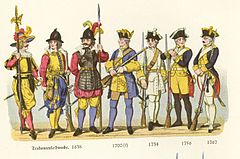Etymology and terminology

In English, use of the term infantry began about the 1570s, describing soldiers who march and fight on foot. The word derives from Middle French infanterie, from older Italian (also Spanish) infanteria (foot soldiers too inexperienced for cavalry), from Latin īnfāns (without speech, newborn, foolish), from which English also gets infant. The individual-soldier term infantryman was not coined until 1837. In modern usage, foot soldiers of any era are now considered infantry and infantrymen.
From the mid-18th century until 1881 the British Army named its infantry as numbered regiments "of Foot" to distinguish them from cavalry and dragoon regiments (see List of Regiments of Foot).
Infantry equipped with special weapons were often named after that weapon, such as grenadiers for their grenades, or fusiliers for their fusils.note These names can persist long after the weapon speciality; examples of infantry units that retained such names are the Royal Irish Fusiliers and the Grenadier Guards.
More commonly in modern times, infantry with special tactics are named for their roles, such as commandos, rangers, snipers, marines, (who all have additional training) and militia (who have limited training); they are still infantry due to their expectation to fight as infantry when they enter combat.
Dragoons were created as mounted infantry, with horses for travel between battles; they were still considered infantry since they dismounted before combat. However, if light cavalry was lacking in an army, any available dragoons might be assigned their duties; this practise increased over time, and dragoons eventually received all the weapons and training as both infantry and cavalry, and could be classified as both. Conversely, starting about the mid-19th century, regular cavalry have been forced to spend more of their time dismounted in combat due to the ever-increasing effectiveness of enemy infantry firearms. Thus most cavalry transitioned to mounted infantry. As with grenadiers, the dragoon and cavalry designations can be retained long after their horses, such as in the Royal Dragoon Guards, Royal Lancers, and King's Royal Hussars.
Similarly, motorised infantry have trucks and other unarmed vehicles for non-combat movement, but are still infantry since they leave their vehicles for any combat. Most modern infantry have vehicle transport, to the point where infantry being motorised is generally assumed, and the few exceptions might be identified as modern light infantry, or "leg infantry" colloquially. Mechanised infantry go beyond motorised, having transport vehicles with combat abilities, armoured personnel carriers (APCs), providing at least some options for combat without leaving their vehicles. In modern infantry, some APCs have evolved to be infantry fighting vehicles (IFVs), which are transport vehicles with more substantial combat abilities, approaching those of light tanks. Some well-equipped mechanised infantry can be designated as armoured infantry. Given that infantry forces typically also have some tanks, and given that most armoured forces have more mechanised infantry units than tank units in their organisation, the distinction between mechanised infantry and armour forces has blurred.
The terms "infantry", "armour", and "cavalry" used in the official names for military units like divisions, brigades, or regiments might be better understood as a description of their expected balance of defensive, offensive, and mobility roles, rather than just use of vehicles. Some modern mechanised infantry units are termed cavalry or armoured cavalry, even though they never had horses, to emphasise their combat mobility.
In the modern US Army, about 15% of soldiers are officially Infantry. The basic training for all new US Army soldiers includes use of infantry weapons and tactics, even for tank crews, artillery crews, and base and logistical personnel.
Comments
Post a Comment